Here, you find my whole video series about Fourier Transform in the correct order and I also help you with some text around the videos. If you want to test your knowledge, please use the quizzes, and consult the PDF version of the video if needed. In the case you have any questions about the topic, you can contact me or use the community discussion in Mattermost and ask anything. Now, without further ado, let’s start:
Part 1 - Introduction
Let’s start by explaining what we will cover in this course. We will start with a discussion about Fourier series for periodic functions. This is an important topic to understand while the Fourier transform as an integral transform actually makes sense. After this, we can define the continuous Fourier transform and discuss the properties. Especially for the first part, we will need a lot of Linear Algebra topics, especially about inner products and orthonormal bases.

Part 2 - Trigonometric Polynomials
Let’s start with the discussion of Fourier series. For this, we first have to define what a so-called trigonometric polynomial is. We will describe the real version of these and the complex version. Both are essentially equivalent but for the introduction into the topic, the representation with sine and cosine functions is easier to visualize.
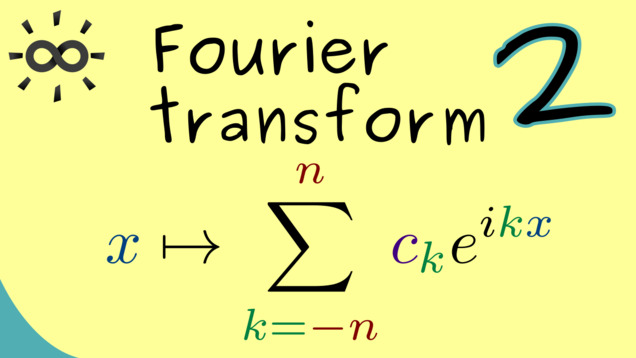
Part 3 - Orthogonal Basis
We consider the vector space $ \mathcal{P}_{2 \pi -per} $ of the real trigonometric polynomials together with an inner product. This means that the notion orthogonality makes sense. In particular, the sine and cosine functions are perpendicular. It turns out that we find an orthogonal basis for this vector space.

Content of the video:
00:00 Introduction
00:45 Real trigonometric polynomials
01:30 Subspace of trigonometric polynomials
02:41 Inner product for trigonometric polynomials
04:11 Examples
11:54 Result: OB for trigonometric polynomials
12:55 Credits
Part 4 - Orthonormalbasis of Trigonometric Functions
After finding an orthogonal basis in the last video, we can ask the question if we also have a nice orthonormal basis, where every vector is normalized with respect to the given inner product. This is possible if we scale the standard cosine and sine functions with a suitable constant. Alternatively, it’s also possible to scale the inner product to get an orthonormal basis. Here, we consider three possible cases for such an inner product.
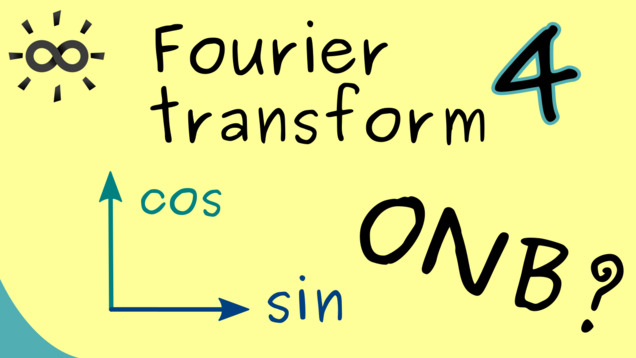
Part 5 - Integrable Functions
As a quick interlude, we have to talk about the vector spaces $ \mathcal{L}^1 $ and $ L^1 $ and the corresponding ones denoted by $ \mathcal{L}^2 $ and $ L^2 $. Rougly speaking, they just describe the vector spaces given by the integrable functions and the square-integrable functions, respectively. To describe them in an efficient way, we have to put in some knowledge from measure theory.

Part 6 - Fourier Series in L²
Now, we are finally ready to define the Fourier series for periodic functions that are integrable over one period. However, we first focus on square-integrable functions because there we have an inner product and the interpretation given by an orthogonal projection. The Fourier series will be denoted by $ n\mapsto \mathcal{F}_n(f) $.
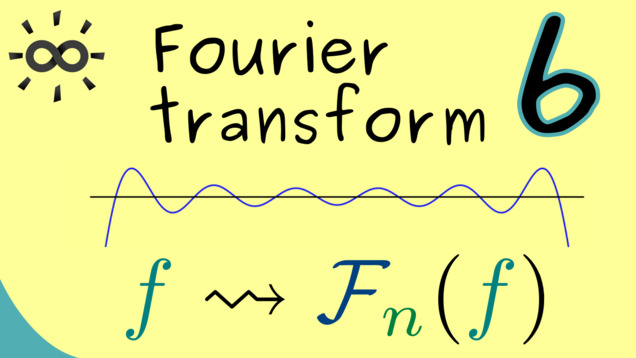
Part 7 - Complex Fourier Series
We already know that trigonometric polynomials can alternatively be represented by complex exponential functions of the form $ e^{i k x} $. However, we didn’t talk how the translation from the cosine and sine functions actually works. Let’s discuss this now and let’s also rewrite the Fourier series in this form. It turns out that everything looks much simple with complex exponential functions.
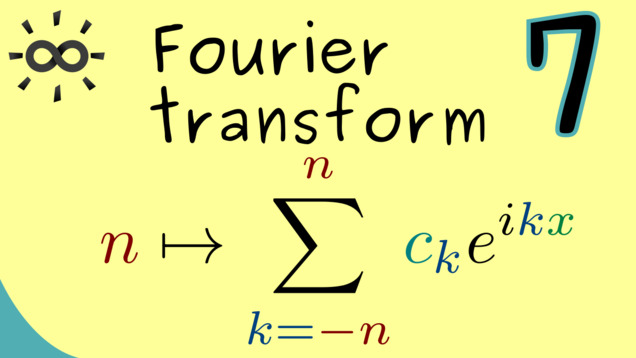
Part 8 - Bessel’s Inequality and Parseval’s Identity
Here, we will discuss some general facts that hold in inner product spaces. Since we have $\mathcal{L}^2$ with our inner product, we can apply the so-called Bessel’s inequality to Fourier series. It turns out that Parseval’s identity is exactly what we want to have for the Fourier coefficients such that the Fourier series converges to the original function.

Part 9 - Total Orthonormalsystem
Let’s quickly discuss equivalent statements to Parseval’s identity, which we can use in later videos. One of them is to say that the orthonormal system we discuss is complete and another is to say that it is total.

Part 10 - Fundamental Example for Fourier Series
In order to show Parseval’s identity for all square-integrable functions, we first have to look at simple functions, so-called step functions. It turns out that there is a special step functions that can be used as a basis for all step functions, we call it $h_a$ for $a \in [-\pi, \pi]$. Hence, in this video, we first show Parseval’s identity for $h_a$ and this will already make some work.
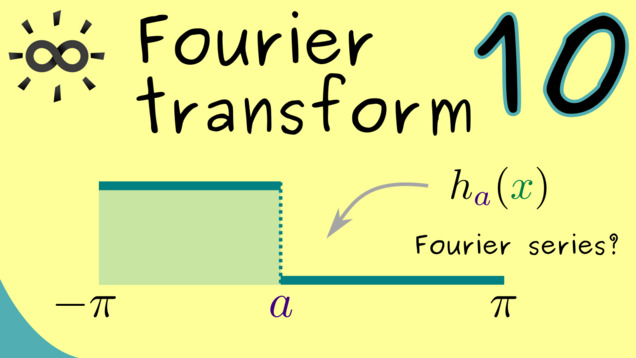
Content of the video:
00:00 Introduction
00:47 Parseval’s identity for step functions
01:47 Fundamental Step Function
03:42 Fourier Series for Step Function
05:53 Visualization
08:10 Proof of Parseval’s identity
15:37 Credits
Part 11 - Sum Formulas for Sine and Cosine
This is a technical video where we prove some useful formulas for the theory of Fourier series. One function involved here is often called the Dirichlet kernel but we will not go into it too much. Our goal is to prove the sum formula that we used in the last video. This will be an essential ingredient for our explanation of the theory about approximations with Fourier series.
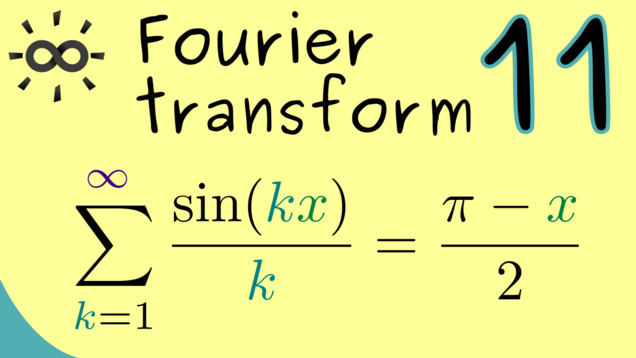
Content of the video:
00:00 Introduction
01:00 Statement for Cosine Formula
01:51 Note about finite sum of Cosine functions
07:10 Lemma about Sine Formula
08:40 Proof of Lemma
17:13 Visualization of Lemma
18:00 Theorem (Cosine Formula)
18:30 Proof of Theorem
22:22 Applying Weierstrass M-Test
23:57 Find integration constant
25:23 Credits
Part 12 - Parseval’s Identity for Step Functions
Now, we can put everything together and can extend Parseval’s identity to all possible step functions. The key element there is that we have already shown the equality for the special step function $ h_a $. By considering the span of these functions and using some linearity arguments, we can formulate the proof for all step functions.

Part 13 - Fourier Series Converges in L²
After the previous work, we can finally formulate the convergence theorem for $L^2$-functions. Indeed, Parseval’s identity holds for every function $f \in L^2_{per}(\mathbb{R}, \mathbb{C})$ which means that the Fourier series converges with respect to the $L^2$-norm. We will prove this statement by approximating with step functions, for which we already know Parseval’s identity.

Part 14 - Uniform Convergence of Fourier Series
At this point, we know that the Fourier Series $ \mathcal{F}_n(f) $ converges to $f$ in the $L^2$-norm. However, this tells us nothing about pointwise convergence at a single point. How can we improve this? It turns out that we can improve it a lot when we consider piecewise $C^1$-functions. There we even have the much stronger uniform convergence, which also includes the pointwise convergence and the $L^2$ convergence. Let’s formulate this theorem and look at an example.

Part 15 - Proof of Uniform Convergence
Now to finish what we have started in the last video: let’s formulate the proof of the theorem about the uniform for piecewise $C^1$-functions. One crucial trick is to use integration by parts for calculating the Fourier coefficients $c_k$ for $k \neq 0$.

Part 16 - Calculating Sums with Fourier Series
Since we have the uniform convergence for continuous piecewise $C^1$-function, we can use the Fourier series to evaluate functions at particular points. This can lead to some special sum formulas which might be hard to prove in other ways. In this video, we consider a quadratic function on $[\pi, \pi]$ and extend it $2 \pi$-periodically.

Part 17 - Pointwise Convergence of Fourier Series
Now, let’s finally talk about the pointwise convergence of a Fourier series, even for non-continuous functions. It turns out that we weaken the assumptions from the last videos even more if we just want that the Fourier series convergences pointwisely. We will also find a very nice result. For example, if our function $f$ jumps from 0 to 1 at the origin, then the Fourier series $\mathcal{F}_n(f)(0)$ will converge to $\frac{1}{2}$, assuming that some differential quotients for $f$ exist.

Part 18 - Dirichlet Kernel
In order to prove our latest theorem about the pointwise convergence, we need to talk about the mathematical core behind the Fourier transform. It’s the so-called Dirichlet kernel and we have already talked about it without mentioning the name. Now, we are ready to formulate the crucial properties of it.

Part 19 - Proof of Pointwise Convergence of Fourier Series
By using the Dirichlet kernel, we can finally write down the proof of the theorem about the point convergence.
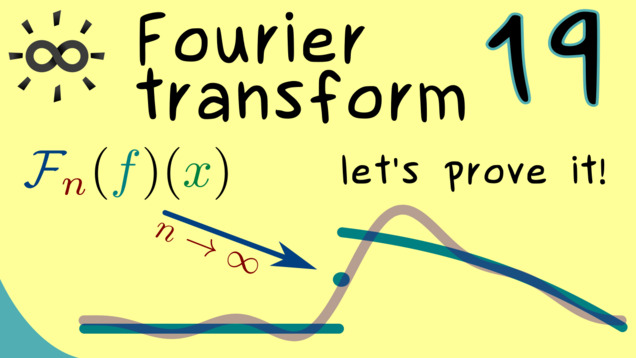
Summary of the course Fourier Transform
- You can download the whole PDF here and the whole dark PDF.
- You can download the whole printable PDF here.
- Test your knowledge in a full quiz.
- Ask your questions in the community forum about Fourier Transform
Ad-free version available:
Click to watch the series on Vimeo.